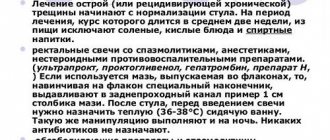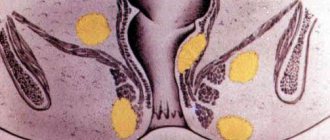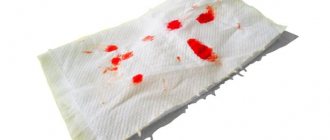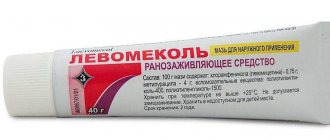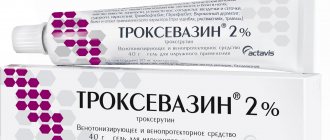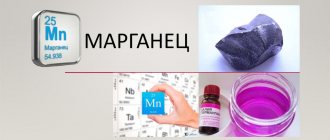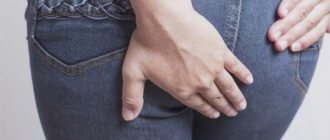Such processes are often accompanied by spasms and pain.
Bleeding also increases, and numerous tissue damages become a “gateway” for various pathological bacteria and fungi. It is necessary to figure out how to treat hemorrhoidal fissures, what medications and folk remedies can be used to solve both problems at once, and the dangers of not seeing a doctor in a timely manner.
How are anal fissures and internal hemorrhoids related?
A rectal fissure is a separation of the mucous membrane of the rectal canal in the anus. Such tissue tears are most often small in size: less than 2 centimeters in length, 4 millimeters in width and 3 millimeters in depth.
The discrepancy of the rectal tissue itself is extremely rare and indicates the presence of serious problems in the anorectal region in particular and in the digestive tract in general. For example, a common cause of rectal fissures is the hemorrhoidal process.
Chronic varicose veins of the anal veins significantly reduce the elasticity of the mucous membrane of the rectal canal. When exposed to unfavorable factors, tissues begin to crack and burst, forming bleeding and painful tears.
Additionally, the following pathogenetic factors provoke the occurrence of anal fissures:
- previously suffered mechanical damage to the anal area, resulting from incorrect (or excessively frequent) enema administration or diagnostic instrumental manipulations;
- constant constipation, which forces the patient to strain very hard, which leads to increased pressure in the rectal area;
- injury to the already inflamed mucous membrane with solid fecal matter;
- practice of non-traditional sexual intimacy without the use of recommended lubricants;
- frequent loose stools that irritate the mucous membranes of the lower intestine;
- inflammatory processes in the gastrointestinal tract (proctitis, gastritis, dysbacteriosis, etc.), which increase the sensitivity of tissues to other influences.
It should be clarified that often an anal fissure and hemorrhoids develop for the same reasons. Therefore, in order to get rid of both proctological problems, it is necessary to find out the source of the pathological process and eliminate its negative impact on the body.
Stages of pathology
About 90% of anal fissures occur in the posterior midline. 10% - in the anterior midline, more often in women. Only 1% is in the dentate line.
The exact etiology is not known, but very hard stools and anal trauma increase the likelihood of fissures. Other causes of anal fissures may occur in patients with chronic diarrhea, during childbirth, and during drug use.
If an anal fissure occurs in an unusual location, it may be caused by syphilis, other sexually transmitted diseases, tuberculosis, leukemia, inflammatory bowel disease, previous anal surgery, HIV infection, and colorectal cancer.
Once a fissure forms, continued pain can cause sphincter spasm (hypertonicity), which causes the wound edges of the fissure to rupture. Crack rupture impairs recovery processes. Local ischemia due to spasm is thought to contribute to anal fistulas, especially in the posterior quadrant where blood flow is significantly less than in other quadrants.
Human immunodeficiency virus is one of the possible causes of severe cracks in the rectum
Evidence suggests that decreased blood flow to the anus and internal sphincter plays a role in the development and healing of fissures. Hypertonicity of the sphincter can lead to decreased blood flow in the area of the fissure.
Anal fistula
Most anal fistulas arise from anal tissues that become infected by various pathogens. Inflammation leads to the formation of abscesses. If the abscess ruptures, a fistula forms.
Other causes of anal fistulas include open perianal or ischiorectal abscesses. Fistulas also occur in patients with inflammatory bowel disease, especially Crohn's disease. The incidence of cracks in CD is 30-50%. Perianal activity often parallels the process occurring in the small intestine, but sometimes it can be the main site of disease.
Anal fistulas can be caused by diverticulitis, actinomycosis, chlamydia, lymphogranuloma venous (LGV), syphilis, tuberculosis and HIV infection. About 30% of patients with HIV infection suffer from anorectal abscesses and fistulas.
Anal fistulas are classified into the following 4 general types:
- Intrasphincteric - affects the dentate line to the anal margin;
- Transsphincteric - affects the external sphincter;
- Suprasphincteric - affects the anal tissue and the entire surrounding sphincter, ending in the icriorectal fossa;
- Extrasphincteric - begins high in the anal canal, covering the entire sphincter and ending with the skin covering the buttocks.
Symptoms of acute and chronic rectal fissures
Despite its small size, tissue divergence in the rectal canal can significantly “poison” human life, since it is characterized by increased pain. This is due to the huge number of nerve receptors located around the anus.
Rectal fissures in hemorrhoids come in two main varieties.
- Spicy. Damage to the mucous membrane around the anus manifests itself in severe pain, but mainly during bowel movements. Manifestations are not cyclical and usually last no more than 4-6 weeks.
- Chronic. The pain is not too pronounced, but can occur not only after visiting the restroom, but also after being in one position for a long time. It is characterized by an extended wave-like course with periods of exacerbation of symptoms and improvement of the condition.
To distinguish between these conditions, it is necessary to consider in more detail the main clinical symptoms of acute and chronic hemorrhoids and anal fissures.
Table. Comparison of acute and chronic rectal ruptures.
| Symptoms of the pathological process | Acute course | Chronic course |
| Pain syndrome | The pain is pronounced, throbbing, twitching. It develops during bowel movements and lasts about 30 minutes. | The pain syndrome is moderately intense. It usually appears after visiting the restroom and goes away extremely slowly. |
| Spasmodic reactions in the sphincter | Sharply expressed, additionally increase pain. | Occur periodically, but increased sphincter muscle tone is not able to reach peak values. |
| Itchy sensations | They occur only when hemorrhoids and fissures occur together. | They are almost always noted by patients. |
| Bleeding | Bloody discharge is observed during bowel movements, most often in the form of drops, but red streams are not excluded. | Traces of bloody discharge can be found on underwear, toilet paper or stool. |
| Appearance | Usually difficult to notice during normal examination. | It is also hardly noticeable, but upon palpation you can feel the sentinel tubercle (compacted edges of the rectal fissure). |
| The cyclical nature of the process | Not typical. | The pathological process occurs cyclically - there are remissions and attenuations. |
Suppositories for the treatment of anal fissures
For internal hemorrhoids with the formation of cracks in the rectum, rectal suppositories are considered effective.
- Aurobin suppositories are a complex product. They are characterized by a pronounced antipruritic, analgesic effect, relieve inflammation, and heal hemorrhoidal fissures of the anus.
- Relief is a group of rectal suppositories that help speed healing and are safe. Prescribed to children and women during pregnancy.
- Suppositories with glycerin. Suppositories for hemorrhoids with a laxative effect prevent constipation. Glycerin moisturizes the intestinal mucosa and helps heal microscopic defects. It is recommended to administer in the mornings and evenings, after bowel movements.
When using suppositories and ointments, you must wash your hands thoroughly before the procedure. The drug is stored in the refrigerator. Before use, remove rectal suppositories from the refrigerator and hold them in your hands until they melt. It will be easier to enter.
Diagnosis of hemorrhoidal fissures
In the normal state of the sphincter, it is extremely difficult to detect a rectal fissure. The patient is asked to strain slightly, as if having a bowel movement. At this point, the rectal opening begins to descend, exposing the inner lining that covers the anal ring.
In this case, the specialist sees with the naked eye a defect in the mucous membrane of the rectal canal, which extends to the skin of the perianal area. The crack is always located longitudinally, hiding between the leathery folds of the anus.
In acute pathological processes, rectal examination is difficult due to strong spastic reactions and pain. For anesthesia, locally acting ointments are used. Study of the deep parts of the rectum (anoscopy, rectoscopy, colonoscopy) can be prescribed only after acute symptoms have been relieved.
In differential diagnosis, anal fissures are distinguished from perirectal fistulas, syphilitic chancre, ulceration of the rectum, and skin lesions of tuberculous or mycotic origin.
The main causes of cracks
AT is a superficial linear rupture of the epithelial tissue of the anal canal. Anal fissures are often caused by local trauma. Too hard stool can damage the “delicate” perianal tissue. A secondary cause of AT is chronic inflammatory bowel disease (ulcerative colitis or Crohn's disease). ATs are considered one of the most common anorectal disorders in pediatrics. Adults also suffer from this disease.
Cracks are called "acute" if they have been present for less than 8 weeks. If the fissure is present in the patient for more than 12 weeks, they speak of a chronic form of the disease.
Anal fistula (AS) is an inflammation of the tract between the anal canal and the skin. There are 4 types of fistulas, based on the relationship between the fistula and the sphincter muscles. AS is classified as “simple” or “complex”.
Simple AS involves low transsphincteric and intersphincteric fistulas that cover 30% of the external sphincter. Complex AS are called high transsphincteric, suprasphincteric and extrasphincteric fistulas. Complex AS occurs due to inflammatory bowel disease, radiation, malignancy, fecal incontinence, or chronic diarrhea.
Patients wonder how to distinguish whether a hemorrhoid hurts or a fissure? With hemorrhoidal disease, bleeding from the anus rarely occurs. Hemorrhoids only bleed at the last stage, whereas with AT, bleeding almost always occurs. An accurate differential diagnosis can only be carried out by a qualified doctor.
Hemorrhoids are pathological expansion of hemorrhoids due to inflammatory or other causes
Important! You should not try to distinguish hemorrhoids from AT on your own. To make an accurate diagnosis, it is recommended to undergo a rectal examination. Only a trained doctor can recognize the disease and distinguish between diagnoses.
How to treat hemorrhoids with rectal fissure?
To treat hemorrhoids and fissures, several techniques are used, which can be divided into three main categories:
- conservative therapy (use of medications);
- surgical interventions;
- use of folk recipes.
The choice of the leading therapeutic method depends on the severity of the hemorrhoidal process, the size of the rectal fissure, the presence of concomitant diseases and the individual characteristics of the patient’s body.
In addition, an integrated approach to the treatment of hemorrhoids and anal fissures is important. If you focus solely on the use of medications, then you may not expect a special effect. It is necessary to strictly follow a special diet and carry out hygiene procedures.
In general, the complex of therapeutic measures consists of the following important measures.
- Diet food. To improve intestinal motility and soften stool, cereals and fruits that are rich in digestive fiber are introduced into the diet. You should not consume alcoholic beverages, fried, salty or spicy foods.
- Hygiene. After each visit to the restroom, it is recommended to wash the anus with antiseptics or decoctions of medicinal plants (chamomile, marigold, sage, etc.).
- Medicines. Suppositories, ointments, laxatives and antispasmodics help relieve most negative symptoms: pain, spasms, inflammation, bleeding, constipation, etc.
- Enemas. They are not always prescribed, but only in cases where dietary nutrition has not helped improve bowel movements. In addition, enemas with a healing solution can heal rectal fissures and hemorrhoids.
- Sitz baths. Such procedures are carried out both to heal damaged tissues and to relieve spasms of the anus. In the latter case, baths are indicated before visiting the restroom to facilitate bowel movements.
The question of how to treat hemorrhoids and fissures is decided by a proctologist. If he recommends surgical methods after conservative therapy has not yielded positive results, you must agree. It is not always possible to cope with the problem solely with the help of medications.
Conservative treatment of hemorrhoids and fissures
For acute fissures, conservative therapy is indicated. Most often, specialists prescribe topical medications, that is, ointment and gel products, as well as rectal suppositories. It is possible to take tablets - laxatives, antispasmodics and venotonics (for the treatment of hemorrhoids).
Rectal suppositories
Suppositories are an easy-to-use pharmaceutical form that allows active ingredients to quickly penetrate damaged tissues. Additionally, many candles contain cocoa butter and other fatty components, which simultaneously moisturize the skin and have a laxative effect.
It is better to treat hemorrhoidal fissures with complex-action drugs that contain anesthetic, anti-inflammatory and antispasmodic components. Suppositories are used twice a day - after waking up and before bedtime.
Table. Suppositories used to treat anal fissures.
| Drug name | Therapeutic actions | Contraindications | Price |
| Posterisan | Stimulation of local immunity, relieving inflammation and itching, accelerating healing and regeneration of damaged areas. | Allergy to the components of the drug. | From 380 rubles. |
| Proctosan | Relieving inflammation, pain, promoting rapid healing of cracks, drying the skin, astringent effect. | Infection of the anus, allergy to components, age under 18 years. | From 340 rubles. |
| Ultraproct | Quick relief of inflammation, pain, acceleration of healing and regeneration processes. | Infections in the anal area, intolerance to ingredients, first trimester of pregnancy. | From 620 rubles. |
| Natalsid | Healing of cracks, relieving inflammation, stopping bleeding. | Allergy to the ingredients included in the composition. | From 330 rubles. |
| Methyluracil | Stimulation of regeneration processes in the area of damage to the mucous membrane and skin, increasing local immunity. | Malignant tumors, allergies to the components of the drug. | From 80 rubles. |
| Salofalk | Rapid elimination of inflammatory processes in the intestines. | Liver and kidney failure, allergies to the drug, gastrointestinal ulcers. | From 1000 rubles. |
| Sea buckthorn oil | Stimulation of wound healing processes, increasing local immunity, protecting cells from damage. | Allergy to components, loose stools. | From 80 rubles. |
| Relief | Stopping bleeding, stimulating the immune system, accelerating wound healing and regeneration processes. | Thromboembolism, allergy to ingredients, granulocytopenia. | From 340 rubles. |
Ointments for hemorrhoidal fissures
The best ointments for rectal fissures contain a fatty base that softens the skin, helps relieve inflammation and stimulate regeneration processes. The drugs are administered once or twice a day after defecation and hygiene measures. The ointments presented below are effective in the fight against both cracks and hemorrhoids.
Table. Ointments used to treat rectal fissures.
| Drug name | Therapeutic actions | Contraindications | Price |
| Ultraproct | Quick relief from itching, inflammation, pain, promoting wound healing and tissue regeneration. | Infectious processes in the anus, allergies to components, first trimester of pregnancy. | From 600 rubles. |
| Proctosan | Relieving inflammation, pain, accelerating wound healing, drying the skin. | Anal infection, allergy to ingredients. | From 350 rubles. |
| Methyluracil | Stimulating epithelization in damaged areas, accelerating tissue regeneration, increasing immunity. | Malignant tumors, allergic reactions to the components of the drug. | From 80 rubles. |
| Solcoseryl | Improving metabolic processes, strengthening local protective reactions, accelerating tissue regeneration, strengthening blood vessels. | Allergic reactions to the components of the drug. | From 300 rubles. |
| Levomekol | Relieving inflammation, swelling, destroying pathogenic microorganisms, regenerating damaged tissues. | Ingredient intolerance. | From 100 rubles. |
| Bepanten | Stimulation of regeneration processes in affected tissues, healing of mucous membranes and horse integument, normalization of cellular metabolism. | Intolerance to the components of the drug. | From 400 rubles. |
| Nitroglycerin ointment | Vasodilation and relaxation of the sphincter, improving blood circulation and eliminating spastic reactions in the anal area. | High blood pressure, serious heart disease. | Prepared in pharmacies according to prescription. |
| Aurobin | Relieving inflammation, pain, accelerating wound healing and regeneration processes in damaged areas. | Skin infections in the area of application, allergies to components, first trimester of pregnancy. | from 280 rubles |
Effective ointments
List of proven ointments for the treatment of external hemorrhoids:
- Levomekol. The ointment contains antibiotics and healing components. It has an anti-inflammatory, drying effect. During treatment, itching and pain in the area of the rectal fissure quickly disappear. The ointment is applied after first washing the perineal area with cool water. The ointment is applied to a sterile napkin and applied to the affected area. The course of treatment is 15 days, 2 times a day.
- Bepanten is a cream for rapid healing of bleeding wounds, abrasions, and anal fissures. Helps stop moderate bleeding from the area of mucosal rupture. The cream is applied to dry skin in a thin layer. It's better to do it lying down. After applying the cream, you need to lie down for a couple of minutes. Absorbs into the skin. It is recommended to empty your intestines before use. The anal area is washed and thoroughly dried with a soft cloth. Apply 2 times a day.
- Proctosan ointment has an analgesic and anti-inflammatory effect. The composition contains bismuth and titanium salts and local anesthetics. The product is applied to the affected area of the anus three times a day.
Surgical treatment of fissures
Internal hemorrhoids or an acute anal fissure do not seem to be a particularly serious problem. However, in some cases they resort to such a forced measure as surgical intervention. This usually occurs when drug treatment is insufficiently effective or when seeking medical help is delayed.
Indications for surgery
Acute rupture of the rectal mucosa is usually treated with drug therapy. But if the process has become chronic, then it will no longer be possible to get rid of an anal fissure solely with the help of ointments, suppositories and dietary nutrition.
We can talk about a chronic form of rectal pathology if more than 1.5 months have passed since the onset of the process, and the negative symptoms have persisted. In such a situation, it is often possible to eliminate the problem only through surgical intervention.
Such a radical method of treating hemorrhoidal fissures is indicated in the presence of the following symptoms:
- the occurrence of pain with each bowel movement. The pain increases after pushing and persists for another half hour;
- periodically occurring spastic reactions in the sphincter area, leading to fear of defecation and so-called psychological constipation;
- spotting in stool, toilet paper, or underwear;
- constant cases of relapses, even after drug treatment. Symptoms increase with constipation, poor diet, increased physical activity, and strong straining during bowel movements;
- penetration of pathogenic microorganisms into cracks and, as a consequence, the development of purulent processes;
- thickening and compaction of the edges of the rectal fissure;
- tissue deformation and the formation of the so-called sentinel tubercle, which is thickened areas of connective tissue.
Radical intervention is also indicated in the case of an acute form of the disease. If the tissue rupture does not heal within two weeks from the start of conservative therapy, the doctor may decide to prescribe surgical treatment.
Types of operations
To cure chronic hemorrhoidal fissures in patients, proctologists use two main types of surgery:
- simple excision of the rupture of the rectal mucosa;
- combining the previous method with lateral or posterior sphincterotomy.
Both surgical techniques are performed in both inpatient and outpatient settings. In the first case, general anesthesia is required, in the second, the surgeon can perform manipulations under local anesthesia (a half-percent Marcaine solution is often used).
In the case of an inpatient operation, the patient remains in the hospital for several days. With local anesthesia, the patient can leave the medical facility within 2-3 hours after surgery.
The duration of the procedure does not exceed 15-20 minutes. The wound surface remaining after excision heals in approximately 7-10 days. Complete restoration of damaged tissues and functions of the rectum takes approximately 14 days.
Preparatory activities
Preparatory measures for surgery on the lower intestine, as well as the operation itself, usually do not cause any special problems or difficulties. The standard process includes several diagnostic and hygiene procedures.
- Since cracks, as mentioned above, indicate serious problems in the gastrointestinal tract, additional tests are necessary. Such instrumental diagnostic methods as irrigoscopy, rectoscopy, ultrasound, etc. will help to study the intestines.
- The study of rectal fissures and hemorrhoids also involves passing laboratory tests (urinalysis, stool analysis, complete blood count).
- If the patient has serious concomitant diseases, consultations (and specialized diagnostic procedures) will be required from a cardiologist, therapist, gastroenterologist, etc.
- To prepare the gastrointestinal tract for intervention, it is necessary to adjust the diet. Legumes, smoked meats, baked goods, pickles, and alcoholic drinks are removed from the menu. The table should consist of easily digestible carbohydrate foods.
- To cleanse the digestive tract, enemas are used (in case of severe spasms of the sphincter, the painful symptom is first relieved). The procedures are carried out in the evening and morning.
- We should not forget about hygienic measures, which involve shaving the hair in the anal area and thoroughly washing the anorectal area and perineum.
Be sure to follow all the rules and principles of preparation for surgery that the attending doctor talks about. Failure to comply with dietary and hygienic measures is fraught with the development of complications after surgery.
Features of the intervention
Previously, excision of a rectal fissure was carried out with traditional surgical devices, but nowadays specialists are increasingly using improved techniques, including laser removal, electrocoagulation, and radiosurgical coagulation.
The principle of the operation is the same for all types - the patient is injected with an anesthetic drug, after which the surgeon excises the healed edges of the tear and removes granulation formations at the bottom of the crack. As a result, a fresh wound forms at the site of the defect.
However, each technique has certain features that should be discussed in detail.
- Electrocoagulation. In this case, deformed tissues are exposed to high-frequency electric current. This allows you to destroy thickened and compacted areas. The wound surface heals in about 10 days, without the formation of scars or sutures. The advantages include the bloodlessness of the procedure, the disadvantages are long-lasting pain.
- Radiosurgical coagulation. In this case, high-frequency radio waves are used, which seem to melt pathological formations. Among the advantages, experts and patients note bloodlessness, minimal pain in the anal area after the procedure and rapid healing of damaged tissue. There are no downsides to this technique.
- Laser excision. To remove a rectal tear, a laser is used, which is aimed at the deformed tissue. Under the influence of a narrowly targeted beam, a fresh wound is formed without compactions or thickenings, which quickly heals. Bleeding and pain are practically absent, the patient recovers very quickly.
Simultaneously with the first two methods, the surgeon can also perform a sphincterotomy - dissection of the internal sphincter of the anal canal. This operation eliminates spasms of the anal muscles, as a result, the severity of the pain syndrome is significantly reduced and bowel movements in the postoperative period are significantly facilitated.
Recovery after surgery
A rectal fissure leaves behind an open wound surface, which requires the patient to comply with certain rules regarding hygiene, nutrition and the use of medications. This will allow you to quickly relieve pain and prevent complications.
- Experts advise thoroughly washing the anal area after each bowel movement, as well as after waking up and in the evening. It is also necessary to give up toilet paper, cleaning the anorectal area with warm water or an infusion of medicinal plants.
- To relieve pain, take oral analgesics. In addition, the use of topical drugs is also indicated - ointments and suppositories Proctosan, Posterizan, Natalsid, Gepatrombin G, Ultraproct, Aurobin, drugs with shark liver oil.
- To relieve inflammation and disinfect the wound surface, warm sitz baths are prescribed. The main ingredients are decoctions of marigolds, chamomile, and a weak solution of potassium permanganate. Such procedures significantly accelerate tissue restoration.
- An important element of the recovery period is dietary nutrition. It involves eating foods that will soften the stool and improve intestinal motility. The menu includes kefir, vegetables and fruits, cereals, dried fruits. At the same time, avoid irritating, strengthening and gas-forming foods - white bread, alcohol, smoked meats, etc.
- Another important point is maintaining the water regime. To do this, it is recommended to drink 1.5-2 liters of clean water during the day (the volume depends on the characteristics of the patient’s body). This will further soften the stool.
- Operated patients are advised to avoid increased stress, prolonged sitting or standing, and heavy lifting. Reasonable physical activity will speed up tissue healing and prevent blood stagnation in the anus.
If dietary nutrition does not help improve the functioning of the digestive tract, the doctor may prescribe laxatives. Among the most popular laxatives are Duphalac, Mucofalk, Macrogol, Norgalax, etc.
Diagnostics
Proctologists make the diagnosis of anal fissure based on the following criteria:
- characteristic complaints;
- anamnesis data;
- results of clinical and instrumental examination.
Patients who have an anal fissure complain of pain in the anus during and after defecation, bleeding during bowel movements in the form of streaks in the stool and marks on toilet paper. When collecting anamnesis (information about the development of the disease and previous treatment), doctors identify factors that may be the cause of an anal fissure in a given patient:
- insufficient dietary fiber intake;
- carbohydrate-rich, fatty, spicy foods;
- constipation or diarrhea;
- difficult childbirth;
- cycling, weight lifting.
The proctologist examines the patient on a gynecological chair, in a supine position, with the legs brought as far as possible to the stomach or in the knee-elbow position. Examination of somatically severe patients is carried out in the lateral position. During an external examination of the anus and perineum, the doctor pays attention to the shape of the anus, its gaping, the presence of deformations and scar changes, and the condition of the skin.
During the examination, proctologists determine the presence of a sentinel tubercle. In order to clearly examine the lower edge of the anoderm defect, assess its location, shape and size, the doctor separates the edges of the anus. In the presence of an anal fissure, the proctologist sees a linear or ellipsoidal defect (erosion or ulcer) with smooth edges, which does not extend beyond the anatomical boundaries of the anal mucosa
Using digital examination, doctors determine the presence of anoderm defects, the tonic state of the anal sphincter and the strength of volitional contractions. In the presence of an anal fissure, the sphincter tone is increased. After pain relief, proctologists perform anoscopy, sigmoidoscopy, and colonoscopy. The pressure in the rectal lumen is assessed using profilometry. This research method provides recording of pressure in different planes along the entire length of the anal canal. Using a computer program, a graph of the distribution of pressure values is constructed and the maximum average pressure values and the asymmetry coefficient are calculated. The processing program allows analysis of pressure data at any level of the cross-section of the anal canal.
If the disease lasts no more than 2 months, there are no scar changes in the area of the bottom and edges of the anal fissure, proctologists make a diagnosis of “acute anal fissure”. An anal fissure is considered chronic if one of the following criteria occurs:
- More than 2 months have passed since the first episode of pain;
- the sentinel tubercle and cicatricial edges of the ulcer are determined;
- fibers of the internal sphincter are present at the bottom of the defect;
- there is a fibrous polyp of the anal canal.
After examining the patient, proctologists at the Yusupov Hospital make a differential diagnosis of anal fissure with other diseases of the rectum, which manifest themselves with similar syndromes: hemorrhoids, ulcerative colitis, polyps, cancer.
Make an appointment
Folk remedies
Both the treatment of fissures and hemorrhoids do not exclude the use of alternative medicine recipes. They cannot act as monotherapy, but they perfectly complement conservative and surgical methods of treating rectal pathologies.
Microclysters
Such procedures effectively cope with inflammation of the soft tissues of the anorectal area, pathogenic microorganisms and help accelerate regeneration processes. In addition, enemas further dilute stool, making bowel movements easier.
To reduce negative symptoms, you can make enemas with oil essences, decoctions of medicinal plants and honey. Let's look at these recipes in more detail.
- With honey. The waste product of bees helps reduce inflammation and helps heal cracks. The medicinal solution is prepared simply - 25 grams of honey are diluted in 200 ml of boiled water.
- With infusions of plants. Popular ingredients are chamomile flowers, yarrow herb, St. John's wort, and oak bark. To prepare a healing potion, it is enough to steam 10 grams of raw materials with a glass of boiling water.
- With oil essences. Sunflower or olive oil is usually used to soften bowel movements. To speed up healing, you can use an oil extract from flax seeds or sea buckthorn fruits. A very effective folk recipe!
The procedure itself is simple. To administer a microenema with any filler, it is enough to follow several basic principles.
- A healing solution in a volume of 50 milliliters is heated to body temperature, after which the medicine is placed in a regular syringe (a rubber pear-shaped container with a hard tip).
- The applicator of the device must be lubricated with Vaseline to facilitate insertion of the syringe into the anus. To retain fluid in the rectal canal for as long as possible, you need to lie down on the left side and remain in this position for up to 60 minutes.
Similar procedures are carried out during the day, but the maximum effect is achieved by enemas performed before bedtime. You should first consult a doctor to prevent unwanted consequences.
Sitz baths
Another popular folk method for treating rectal fissures and hemorrhoids is sitz baths. Taking them allows you to reduce the intensity of the inflammatory process, prevent infection and suppuration, reduce pain and activate tissue regeneration.
Infusions of medicinal plants such as chamomile, marigold, burdock, St. John's wort, yarrow, wormwood and sage are actively used as ingredients for the production of healing liquids. Herbs are used either individually (depending on the leading symptom) or as a collection.
The infusion is prepared as follows: 2 tablespoons of plant material are steamed with 1.5 liters of boiled water. After 20 minutes, strain the infusion and pour it into a container with warm water. The temperature of the liquid should be 38 degrees.
After the preparatory manipulations, the patient sits in the pelvis so that the gluteal muscles are separated and the solution washes the anus area. The duration of the procedure is approximately a quarter of an hour, or until the water cools down.
In addition to herbal decoctions, a solution of potassium permanganate is often used for sitz baths. However, it is important to remember that even a small purple grain can cause tissue burns, so the solution is made very weak - slightly pink.
Homemade ointments
Ointment products made according to folk recipes help soften the skin, relieve the inflammatory process and stimulate the regeneration of the epithelial layer. Consider popular homemade ointments.
- With propolis. 10 grams of bee glue are mixed with 100 grams of butter and placed on low heat. After the components are dissolved, the mixture is stirred, filtered and poured into jars.
- With spruce resin. You need to take 20 grams of beeswax, 40 grams of lamb fat and 80 grams of spruce resin. The composition is brought to a boil, thoroughly filtered and cooled, after pouring into containers.
- With beeswax. 20 grams of the wax product are mixed with sunflower oil, put on low heat and brought to complete dissolution, stirring continuously. The composition is poured into jars and stored in the refrigerator.
For anal fissures and hemorrhoids, treatment with homemade ointments follows a certain scheme: the anal area is lubricated with the drug up to two to four times a day.
Homemade rectal suppositories
Homemade suppositories are also used to treat rectal fissures. They allow you to stop bleeding, relieve inflammation, relieve pain from tissue rupture and speed up the healing of damaged areas. Below are the most popular recipes.
- From potatoes. A small “torpedo” is cut out of the root pulp, making sure that there are no burrs or sharp edges. Both fissures and hemorrhoids require extremely careful treatment, so potato suppositories must first be lubricated with olive or sea buckthorn oil. This will enhance the healing effect. The frequency of the procedure is determined by the doctor.
- From propolis. Bee glue, badger fat, 70% alcohol are mixed in equal proportions and the resulting composition is placed in the refrigerator to infuse. A small swab is made from a cotton pad, which is soaked in the resulting mixture and inserted into the anus. The procedure is carried out before falling asleep until complete recovery.
- From herbal infusions. The herbal mixture (oak bark, marigolds, chamomile flowers) is steamed with a liter of hot water, boiled for 5 minutes, filtered. The resulting broth is poured into molds or little fingers from medical gloves and placed in the freezer to harden.
Homemade suppositories combat the symptoms of rectal ruptures and internal hemorrhoidal disease quite well. It is only important to make sure that there are no allergic reactions to the main ingredients of the drugs.
Treatment with tablets
A prerequisite for the expected treatment of anal fissures is the prevention of constipation and diarrhea. Proctologists prescribe medications that help normalize intestinal motility.
Venotonic drugs are prescribed to strengthen the walls of blood vessels and prevent bleeding from dilated hemorrhoidal veins.
In case of severe bleeding from the anus, hemostatic drugs are prescribed in the form of tablets and injections.
Main conclusions
The question of how to treat hemorrhoids and fissures is within the competence of a proctologist. Self-medication of these serious proctological pathologies is completely excluded due to the high risk of complications and undesirable consequences.
Acute ruptures of the rectal mucosa are usually treated with medications and traditional medicine recipes. Chronic anal fissures in most cases are an indication for surgical intervention.
However, it should be remembered that the best results can only be achieved with an integrated approach. That is why the use of medications must be combined with dietary nutrition and compliance with basic hygiene rules. Be healthy!
Prevention measures
To avoid reoccurrence of the cause of hemorrhoids and anal fissures, it is necessary to follow the following preventive measures:
- adhere to a balanced, proper diet;
- exercise regularly;
- treat infectious and intestinal diseases in a timely manner;
- observe the rules of personal hygiene after defecation;
- have vaginal sex;
- undergo a medical examination in a timely manner.
The occurrence of anal fissures is associated with diet, lifestyle, and occupational characteristics. If bothersome symptoms appear, hemorrhoids should be treated using rectal suppositories, external ointments, microenemas, as well as excluding prohibited foods from the daily menu.
We recommend: Treatment of hemorrhoids with aloe at home
